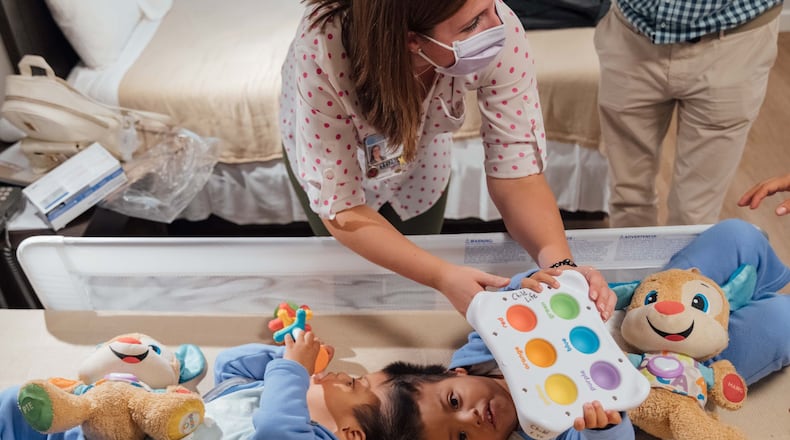“While we all fell in love with Pedro and Augusto during their time here. We are excited for them to return to their home country and culture,” said Ben Goodstein, vice president and chief ambulatory officer. “We will continue to keep an eye on them as their recovery process continues and enjoy their bright future ahead.”
The boys were separated over the course of four major surgeries, returning home to their native country of Guatemala in June. Dayton Children’s chronicled the process in a documentary being released today on the hospital system’s YouTube page following a premiere event at the Victoria Theatre held Wednesday evening.
The documentary followed the time surgeons and staff spent preparing and executing the series of separation surgeries for this complex condition. Interviews with doctors in the documentary included explanations into what considerations there were when it came to separating Pedro and Augusto, as well as clips filmed during the boys’ surgeries, like the moment of separation between the two boys.
“There is very little research or practical knowledge in medical literature about how to separate craniopagus twins, especially those who are connected at this angle,” said Dr. Robert Lober, pediatric neurosurgeon for Dayton Children’s. “This documentary shows the real, sometimes overwhelming process of preparation, discovery and decisions that we went through for these boys, hopefully helping others born with this condition in the future.”
“While we prepared diligently, there were still surprises,” said Dr. Christopher Gordon, chief of craniofacial and plastic surgery at Dayton Children’s. “Through it all, the boys were incredibly strong and their safety was our utmost concern.”
Dayton Children’s physicians go on humanitarian trips to share their services with children who don’t have access to the type of care they require. Gordon had previously been working on providing cleft surgeries in Guatemala when one of the directors of the Shriners introduced Gordon to Pedro and Augusto’s case. Gordon then brought the case back to Dayton.
“Pedro and Augusto, they’re connected at the tops of their heads and they’re slightly rotated,” Lober said. “It’s that rotation that makes this so challenging.”
The boys’ condition resulted in functional disabilities, as well as developmental delays. There were imbalances in blood flows, and their bodies were already showing signs of problems in their organs prior to their separation. If they weren’t separated, doctors speculated the twins would have been confined to spending the majority of their lives in a hospital.
“I came for my sons so they can have a better future,” said the boys’ mother, Luisa, speaking Spanish in the documentary. “I know that they have suffered a lot.”
Hospital staff spoke of connecting with the boys and their personalities.
“The boys will steal your heart with their sweet giggles and dance parties,” said Elise Huntley, certified child life specialist. “They were incredibly strong — and sassy!”
Less than a third of craniopagus twins survive the first 30 days of life, according to Dayton Children’s. There have been very few surgeries on this type of connection and very little data available to gauge the likelihood of a successful separation. The boys’ anatomy was distorted from what doctors were used to, Lober said in the documentary.
After extensive testing, study, and review, Lober and Gordon determined separation would be possible in a series of surgeries. These efforts were also aided by Dr. Akil Patel, a neurosurgeon with Kettering Health.
After two years, four surgeries, and help from more than half a dozen organizations, the boys were officially separated at 5:43 a.m. on April 8, 2022. The separation surgery spanned three days.
“Pedro and Augusto are forever in our hearts and will always have a second home in Dayton,” said Deborah A. Feldman, president and CEO for Dayton Children’s.
Dayton Children’s withheld the last names of the two boys and their mother, citing privacy concerns.
How to watch
The documentary was produced and directed by Flyback Productions, a Chicago-based production company. View the documentary at youtube.com/@DaytonChildrens. This documentary contains graphic medical imagery, so viewer discretion is advised. May not be suitable for children younger than 13.
Conjoined twin fast facts
The type of connection, the degree of connection, the sex of the children and their age at the time of the surgery make the separation of Pedro and Augusto, twins from Guatemala, one of the rarest separation surgeries in the world.
According to Dayton Children’s:
- Only 30% of conjoined twins are male.
- Only one in 200,000 live births are conjoined twins.
- Only an estimated 50 craniopagus conjoined twins are born every year, which is 5% of all conjoined twins. Normally only 15 live longer than a month after birth.
About the Author




